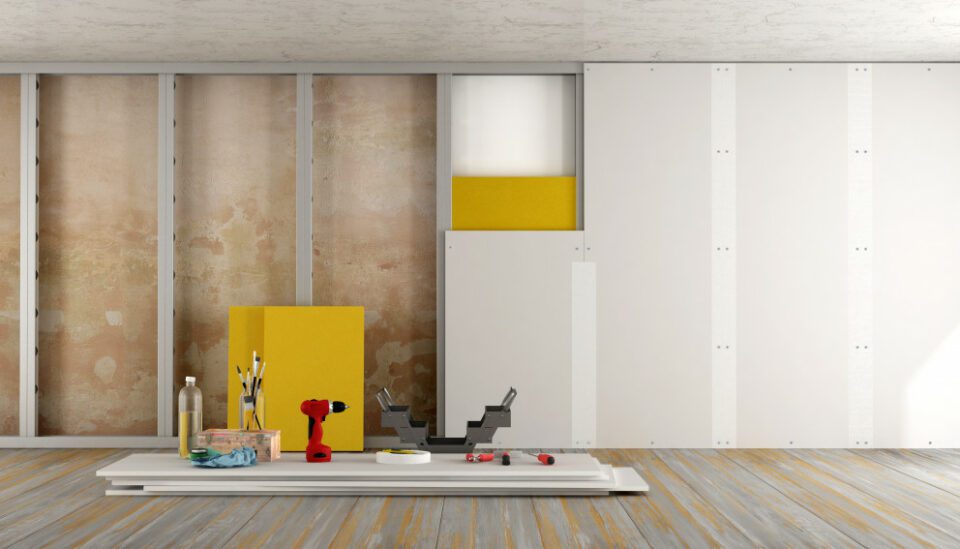Plasterboard Adhesive: Your Resource
Aside from all the fixings that involve plastic and metal, such as screws, nails, and beading etc, there is of course plasterboard adhesive.
Plasterboard adhesives are used to fix plasterboard to solid walls. Attaching plasterboard with adhesive is an effective alternative to battens or studs when covering an existing wall. Plasterboards can be stuck to most surfaces, including stone, brick, concrete and timber. Attaching plasterboards this way is much quicker than building a stud wall, and requires less technical skill.
In terms of which adhesive to use, there are two main options, drywall adhesive and fixing foam. In this guide, we’ll explore the pros and cons of these options, and look at how you can mix and apply them.
We’ll also look at how a different type of drywall adhesive, jointing compound, is used later in the process of making a plasterboard wall.

Drywall Adhesive:
Drywall adhesives are based on Gypsum, a soft sulfate mineral used in many forms of plaster. There are many brands available such as Knauf Plasterboard Adhesive. This type of adhesive is designed to be mixed with water and is relatively inexpensive, with a 25kg bag costing just under £10. Drywall adhesive has a limited shelf life, which will be indicated on the packaging but can be as little as 4 months. The ‘dot and dab’ adhesive method is common in the construction industry and used to attach plasterboard to existing walls.
Fixing Foam:
Fixing foam is a fast-curing adhesive foam that can be applied directly from the container without mixing. It comes in a canister with a trigger control. It is comparable to a grab adhesive but made specifically for plasterboard. It is usable for up to six weeks once opened. A single canister of fixing foam will cost between £8 and £10 and will cover around ten metres.
Using Plasterboard Adhesives
With both drywall adhesive and fixing foam, it’s vital that you correctly measure and cut your plasterboards, remembering to navigate around sockets, skirting boards, and windows.
Dry Wall Adhesive:
Drywall adhesive is applied with the dot and dab method to plasterboards. It is mixed with water in a bucket and should be mixed to a creamy consistent thickness. If the mixture is in any way runny, add some more adhesive powder until the correct consistency is achieved. Once you are satisfied with the consistency of your mixture, start applying it to your wall in medium-sized amounts of mixture (dabs), every 12 inches or so, regularly spaced out.
A solid line of adhesive must be applied just below the ceiling, to comply with fire safety building regulations. It is also recommended to make a continuous line of adhesive around the border of each plasterboard panel, to protect against insect infestation and help secure the boards.
-
- GTEC Wall Lining Adhesive 5L (200/125/503)
2 - 3 WORKING DAY DELIVERY
- 5 Litres
- Non-gypsum contact adhesive
- Knauf Drywall Plasterboard Adhesive 25kg (200/003/001)
2 - 3 WORKING DAY DELIVERY
- Multi-purpose
- Gypsum based
View All Plasterboard Adhesives
Fixing Foam Adhesive:
Fixing foam is applied directly to the back of the plasterboard panels, spraying around the borders and sparingly across the centre. It is then left for a time that should be specified on the canister you are using. The wall you are attaching your plasterboard to will need to be dampened in advance. To attach, the boards will need to be held against the wall in their correct positions until the foam has set, which should take a few minutes. Fixing foam saves time on mixing, is a little more expensive, and has a similarly complex application to that of drywall adhesive.
Both of these methods will also work for insulated or waterproof plasterboard. Plasterboard adhesives can be used on both walls and ceilings, though holding the plasterboard in place for a ceiling may be difficult to do on your own.
What is a Jointing Compound?
Plasterboard jointing compound is used to secure gaps between plasterboard panels to avoid cracking when plastered. This is done with either scrim tape or jointing tape, and plasterboard jointing compound. If using scrim tape you must first run the self-adhesive tape over each gap between plasterboard panels, before applying jointing compound over each seam, securing the boards in place.
With Joining tape strips of paper tape are stuck to the joins between panels using a jointing compound, which is then reapplied, further protecting the joins between panels. Jointing compound is available ready-mixed or as a powder to mix at home.
-
Order Before 3pm For Next Working Day Delivery
-
Order Before 3pm For Next Working Day Delivery
-
Order Before 3pm For Next Working Day Delivery
Quality Plasterboard Adhesives For Sale
When bonding plasterboard, plasterboard adhesives allow you to attach dry lining directly to your walls, letting you stick to wood, stone, or masonry. Both drywall adhesive and fixing foam have comparable application processes, except drywall adhesive is dabbed on the wall and fixing foam is sprayed onto the plasterboard panels. Fixing foam requires less preparation, and is still a strong adhesive. Plasterboard adhesives are also used to connect plasterboards and avoid cracks appearing during the plastering process.
You'll find a full range of plasterboards and plasterboard adhesives for sale through our website. For professionals, our trade accounts open up a world of benefits, including product sourcing through our supply network, express delivery, and trade pricing. Sign up through our website now, or tell us what you need through the form below.















